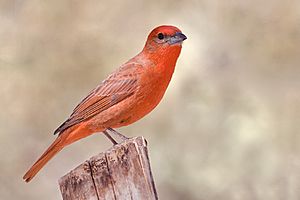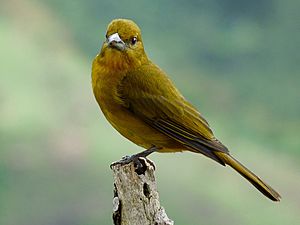Hepatic tanager facts for kids
Quick facts for kids Hepatic tanager |
|
|---|---|
 |
|
| Northern hepatic tanager, Piranga flava hepatica |
|
| Conservation status | |
| Scientific classification | |
| Genus: |
Piranga
|
| Species: |
flava
|
 |
|
| Synonyms | |
|
Piranga hepatica |
|
The hepatic tanager (Piranga flava) is a medium-sized American songbird. It used to be part of the tanager family (Thraupidae). Now, scientists classify it with other birds in the cardinal family (Cardinalidae). This bird looks and sounds a lot like other birds in the cardinal family.
Contents
What's in a Name? The Hepatic Tanager
Why is it called "Hepatic"?
The common name hepatic means "liver-colored." This is because the bird has a brownish-red color. Its scientific name, flava, comes from Latin. It means yellow or golden.
Different Types of Hepatic Tanagers
There are three main groups of hepatic tanagers. Scientists are still studying if these groups might be separate species.
- The hepatica group lives from Nicaragua north. They breed in pine and pine-oak forests. These birds also migrate sometimes.
- The lutea group lives from Costa Rica to northern and western South America. They prefer the edges of highland forests.
- The flava group lives in open woods in other parts of South America.
Meet the Hepatic Tanager: Appearance and Size
Birds from the northern group are bigger and stronger than other Piranga tanagers. They have a short tail and a strong bill. The brightest color on the bird is always on its forehead and throat.
All hepatic tanagers have gray sides and dark cheeks. They also have a dark streak near their eye. Female birds are yellow. Male birds are red. An average hepatic tanager weighs about 38 g (1.3 oz). Its average wingspan is 31.8 cm (12.5 in). The bird's length is about 20.3 cm (8.0 in).
Where Do Hepatic Tanagers Live?
This bird lives in a wide area. You can find it from the southwestern United States to northern Argentina. In the U.S., it lives in Arizona, New Mexico, and sometimes in southern California and Colorado.
How Hepatic Tanagers Behave
The way hepatic tanagers act is similar to the western tanager.
Sounds and Songs
Its call is a low, dry chup sound. This is like the sound made by a hermit thrush. Its song is clearer than other tanagers. It sounds much more like the song of the black-headed grosbeak. The black-headed grosbeak is also a member of the Cardinalidae family. When it flies, its call is a husky and rising weet.
What Do They Eat?
The hepatic tanager looks for food in tree leaves. It moves slowly and carefully. Different birds use different ways to find food. In summer, the northern birds mostly eat insects, spiders, and some fruit. In Mexico, people have seen them eating nectar. From Oaxaca south, they sometimes follow swarms of army ants to find food.
Scientists still don't know much about the daily life of the northern population.
Hepatic tanager species account at Neotropical Birds (Cornell Lab of Ornithology)
See also
 In Spanish: Piranga flava para niños
In Spanish: Piranga flava para niños



